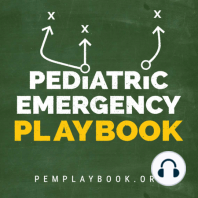30 min listen
Urine Trouble
ratings:
Length:
53 minutes
Released:
Feb 1, 2017
Format:
Podcast episode
Description
When should you commit to getting urine? When can you wait? When should you forgo testing altogether? When do I get urine? Symptoms – either typical dysuria, urgency, frequency in a verbal child, or non-descript abdominal pain or vomiting in a well appearing child. Fever – but first look for an obvious alternative source, especially viral signs or symptoms. No obvious source? Risk stratify before “just getting a urine”. In a low risk child, with obviously very vigilant parents, who is well appearing, you may choose not to test now, and ensure close follow up. Bag or cath? The short answer is: always cath, never bag. (Pros and cons in audio) What is the definition of a UTI? According to the current clinical practice guideline by the AAP, the standard definition of a urinary tract infection is the presence of BOTH pyuria AND at least 50 000 colonies per mL of a single uropathogen. Making the diagnosis in the ED: The presence of WBCs with a threshold of 5 or greater WBCs per HPF is required. What else goes into the urinalysis that may be helpful? Pearl: nitrites are poorly sensitive in children. It takes 4 hours for nitrites to form, and most children this age do no hold their urine. Pearl: the enhanced urinalysis is the addition of a gram stain. A positive gram stain has a LR+ of 87 in infants less than 60 days, according to a study by Dayan et al. in Pediatric Emergency Care. When can I just call it pyelonephritis? In an adult, we look for UTI plus evidence of focal upper tract involvement, like CVA tenderness to percussion or systemic signs like nausea, vomiting, or fever. It is usually straightforward. It’s for this reason that the literature uses the term “febrile UTI” for children. Fever is very sensitive, but not specific in children. The ill-appearing child has pyelonephritis. The well-appearing child likely has a “febrile UTI”, without upper involvement. However, undetected upper tract involvement may be made in retrospect via imaging, if done. How should I treat UTIs? For simple lower tract disease, treat for at least 7 days. There is no evidence to support 7 versus 10 versus 14 days. My advice: use 7-10 days as your range for simple febrile UTI in children. Pyelonephritis should be treated for a longer duration. Treat pyelonephritis for 10-14 days. What should we give them? Sulfamethoxazole and trimethoprim (Bactrim) is falling out of favor, mostly because isolates in many communities are resistant. There is an association of Stevens-Johnson Syndrome (SJS) with Bactrim use. This may be confounded by its prior popularity; any antibiotic can cause SJS, but there are more case reports with Bactrim. Cephalexin (Keflex): 25 mg/kg dose, either BID or TID. It is easy on the stomach, rarely interacts with other meds, has high efficacy against E. coli, and most importantly, cephalexin has good parenchymal penetration. Nitrofurantoin is often used in pregnant women, because the drug tends to concentrate locally in the urine. However, blood and tissue concentrations are weak. It may be ineffective if there is some sub-clinical upper tract involvement. Cefdinir is a 3rd generation cephalosporin available by mouth, given at 14 mg/kg in either one dose daily or divided BID, up to max of 600 mg. This may be an option for an older child who has pyelonephritis, but is well enough to go home. Whom should we admit? The first thing to consider is age. Any infant younger than 2 months should be admitted for a febrile UTI. Their immune systems and physiologic reserve are just not sufficient to localize and fight off infections reliably. The truth is, for serious bacterial illness like pneumonia, UTI, or severe soft tissue infections, be careful with any infant less than 4-6 months of age. Of course, the unwell child – whatever his age – he should be admitted. Think about poor feeding, irritability, dehydration – in that case, just go with your gut and call it pyelonephritis, and admit. What is the age cut-of
Released:
Feb 1, 2017
Format:
Podcast episode
Titles in the series (100)
The Pediatric Surgical Abdomen: Abdominal pain is common; so are strongly held myths and legends about what is concerning, and what is not. One of our largest responsibilities in the Emergency Department is sorting out benign from surgical or medical causes of abdominal pain.... by Pediatric Emergency Playbook
